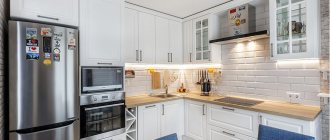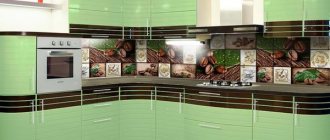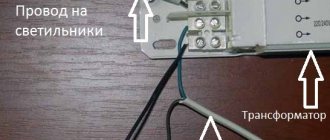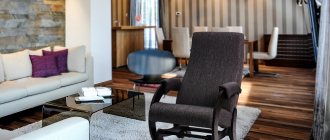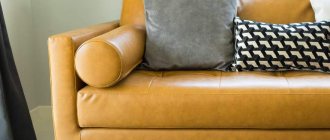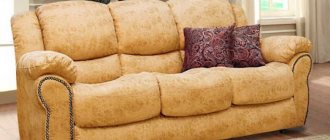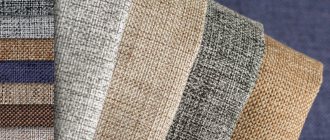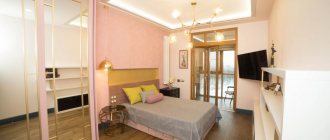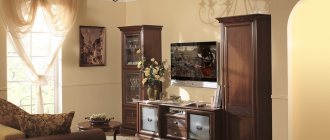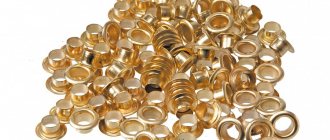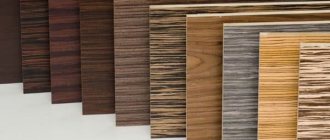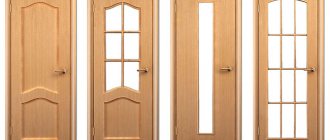One of the most popular and sought-after solutions for decorating kitchen facades is the use of PVC film. You've probably seen this kind of furniture in stores and in friends' kitchens.
Film facades are considered the most affordable and very practical. Let's take a closer look at these products - look at the advantages and disadvantages, and also find out what problems you may encounter when using furniture and how to avoid them.
Kitchen PVC facades - advantages and disadvantages
The kitchen facade in PVC film is a plate covered with a thin layer of polyvinyl chloride.
The advantages of film facades include:
- resistance to deformation and wear resistance;
- PVC is not afraid of moisture and moderate temperature influences;
- a wide selection of shades, coating textures and the ability to purchase a façade of any shape (curved, figured);
- lack of sensitivity to UV rays, due to which the panels do not fade or lose color;
- affordable price compared to veneered, wooden and plastic products.
Film kitchen facades also have disadvantages that you need to know about before purchasing. The first, and most unpleasant one, is that the PVC coating may peel off, especially if the cabinet is located above the hob. In addition, the film is susceptible to mechanical damage and can deteriorate when using cleaning agents with abrasive particles, and is also not subject to restoration (except for cases where it comes off).
Advantages that will surprise
What other advantages of finishing can be highlighted:
- Environmental friendliness. Modern production technologies make it possible to produce facades from “clean” materials.
- Durability. What is this type of furniture? The basis here is MDF, and the film performs both a protective and decorative function. A quality product will last in the kitchen for many years.
- Resistance to chemical agents. Grease stains, water splashes and even difficult dirt will be easy to remove. Film facades are not afraid of cleaning with powder.
- Resistant to fading. Facades covered with film will not lose their color when exposed to sunlight.
Another advantage of such kitchen furniture is the variety of textures, colors and shades. You can choose a single-color set in a fashionable purple or pistachio tone, in a noble wood color or in a bright pink design.
And one more plus that will appeal to connoisseurs of originality: PVC film lends itself well to embossing, dyeing and other design solutions. If you need curved, shaped facades, this coating will be an excellent decorative option.
The photo below shows kitchens where the furniture facades are decorated with matte and glossy films.
In the photo: a glossy top and matte bottom - a fairly common solution.
Base for PVC film coating - materials and requirements
The PVC-coated panel consists of three parts:
- basics;
- films;
- edge finishing (sides).
Not every base is suitable for covering with film. Manufacturers use two options - chipboard and MDF.
Chipboard facades will be cheaper, but their durability is a very controversial issue. This material absorbs moisture well and swells, causing the film to begin to peel off. In addition, the toxic resins that make up chipboard can evaporate into the air when the integrity of the coating is damaged and have a toxic effect on the human body and domestic animals.
It is thanks to cheap chipboard structures that film coating has an undeserved reputation as a low-quality and unreliable material.
Theoretically, PVC can also be coated on panels made of well-sanded natural wood. But, as a rule, the manufacturer does not strive to hide, but rather to emphasize the appearance and natural pattern, so wood is also not suitable for applying film.
PVC coating is best used for facades made of MDF - an environmentally friendly and safe material with high performance characteristics. It does not deform, is resistant to moisture and high temperatures, and its smooth, jagged surface reduces the risk of film peeling.
PVC application technology
Today, there are three main methods of covering MDF parts with PVC films.
Lamination is the process of wrapping MDF blanks under high temperature and pressure, so-called paper-resin materials. When using this method, a uniform surface layer is obtained, and the products are highly durable and waterproof, and are also not afraid of high temperatures.
Laminating . When using this method, a layer of glue is applied to the part in advance, and then using a vacuum press, under temperature and pressure, it is tightly glued to the MDF facade.
Postformation . Here they use a layered laminate or plastic that can withstand certain loads. This method of cladding provides maximum protection and wear resistance to the furniture product.
Let's look at the whole process of laminating furniture facades step by step:
- Preparation of the workpiece. A rough MDF board is cut, then the specified pattern is milled on the product and the ends are processed, after which the facade is sanded and cleaned of dust.
- A layer of glue is applied to the workpiece and time is allowed to dry. Next, the part is placed on the machine on special supports; if there are several products, then the optimal technological gaps for cutting are selected.
- Next, the film is rolled out across the entire machine table and secured with a pressure bar.
- After this, the material over the entire area is heated to temperatures of 140-160 C degrees Celsius.
- Next, the air layer between the film and the table surface is removed, after which, after 2-3 minutes, it is tightly glued to the facade.
- After the product has completely cooled, all excess is cut off along the contour, and we can assume that the facade is ready.
To prevent this material from “peeling off” and “tearing” and from having sharp edges, they are rubbed down with fine-grained sandpaper.
Types of PVC films for kitchen facades
To cover the facades, PVC film with a thickness of 0.05 to 0.8 mm is used. Depending on the application method and performance properties, the following types of material are distinguished:
- membrane-vacuum film (0.25-0.5 mm) - intended for vacuum pressing of bent facades;
- PVC for laminating (up to 0.3 mm) - used for laminating smooth panels;
- PVC for lamination (0.3-0.5 mm) - allows you to laminate surfaces not only in one, but also in several layers.
For home use, self-adhesive film in rolls (0.3-0.5 mm) is used.
PVC coating is applied in one of three ways:
- laminating;
- lamination;
- post-formation.
Laminating is based on preliminary application of glue to the base and pressing the film against it under conditions of high pressure and temperature. The cost of lamination for the manufacturer is much more economical, but the quality of gluing leaves much to be desired - PVC can quickly peel off.
Lamination is the cladding of a façade at critical temperatures. After applying the film, the facade is additionally covered with a protective layer. This method is much more reliable than laminating.
Postforming is the most advanced technology for applying PVC. The film is applied to the surface in an even layer and then placed under a special press. If it is necessary to give the cladding a certain pattern or shape, then it is also adjusted under the press.
<
>
Self-adhesive film can be used to cover furniture at home. First, you need to thoroughly clean the surface of the facade from dust and wipe it with a degreaser (for example, white spirit), and then carefully apply the PVC coating. To get rid of bubbles, the coating can be smoothed with a spatula wrapped in cloth. Unfortunately, such film will not last long.
When choosing a film, pay attention to the country of origin. It is believed that products from European manufacturers are more reliable, PVC from Italy is especially valued. However, factory-made Chinese and Korean film is no worse, but costs less.
Three questions everyone asks
Before purchasing a new headset, the first thing you will do is study reviews. Some buyers will say that this facade is the best because it is cheap. And others will talk about the problems they encountered after several months of using the furniture.
Let's look at the three most common questions asked by future owners of products with PVC film.
Why are some products very cheap and others not?
Here it is worth considering the process of making facades. The basis of the set is an MDF board on which the film is applied. The minimum permissible thickness of PVC is 0.3 millimeters.
The material is applied to the facades by thermal vacuum pressing, due to which the film fills all corners of the product, lies evenly and retains its shape.
Now let's answer the question. If a manufacturer deviates from the rules for making a headset and violates the technology, the facade can be incredibly cheap. When you come to the store, you can see that products made with PVC film coating will have different prices from different manufacturers. The manufacturer could have used thin Chinese film with a thickness of 0.09 mm and low-quality glue instead of a press.
The film will peel off sooner or later, how to avoid this?
Indeed, the PVC film can peel off literally after a week of using the headset. Why does this happen?
An iron can be used to repair edges with peeling film.
Let's go back to the first question. Violation of manufacturing technology can lead to such a problem. Also, the film may not withstand constant load in the form of steam, water and temperature changes.
How to get out of this situation? Choose models for your kitchen from trusted manufacturers. Find out how the furniture is made. Install a powerful hood and ensure that the facades are used in clean and dry conditions.
In the next photo, look at an example of a high-quality and well-maintained set.
How to choose a high-quality façade from all the models?
The answer will be simple: do not chase the best and cheapest offer. As a rule, these products lose their attractiveness after a few months.
Choose a set for your kitchen that is made in compliance with all technological processes.
Ask a consultant to tell you about production, ask questions about the quality of fittings, base and film.
Compare several models from different manufacturers. It’s better to overpay a little than to change the entire kitchen set in a year.
Decorative qualities of PVC film facades for kitchen units
Kitchen PVC facades can have a variety of colors and textures. Film manufacturers take into account fashion trends: as soon as a certain material becomes popular, they produce a PVC coating that imitates its shade and texture. Thanks to this technique, you can purchase facades “metal-like,” “wood-like,” or “glass-like.”
The film can be:
- glossy;
- matte;
- mirror
Thanks to modern technologies, various images and patterns can be applied to PVC coatings. 3D drawings that imitate three-dimensional details - stucco molding, milling or decorative carvings - have become widely popular.
Rules for care and operation - how to extend the service life of a kitchen facade with PVC film coating
The quality of care for PVC facades has a serious impact on their durability and appearance.
To make your furniture pleasing to the eye longer, follow these recommendations:
- do not use abrasive and chemically aggressive chlorine-based detergents to clean the panels;
- protect facades from mechanical damage - scratches and impacts;
- do not expose surfaces to temperatures above 70. If a cabinet with a PVC facade is located above the hob, it is advisable to use a powerful hood;
- Film overcooling is not allowed - up to - 15.
But what to do if the PVC film peels off? In this case, you must first check whether the warranty period for the furniture has expired. If not, the manufacturer will restore the furniture himself, but only if you followed the recommendations for caring for the furniture.
If the warranty period has expired or the coating has peeled off due to careless handling of the facades, you can restore the film yourself.
To do this you will need glue or liquid nails. You can also use PVA; PVA Moment Joiner is especially suitable. It needs to be drawn into a medical syringe (you can use a special glue gun) and carefully inserted under the peeled off section of the film. Then press firmly and remove the remaining substance with a cloth.
Two disadvantages and ways to eliminate them
Now let's look at the shortcomings of the material. The most significant is the likelihood of film peeling under the influence of steam, moisture and temperature changes. It is also worth noting that PVC film has the following disadvantages:
- Does not tolerate mechanical damage well. Any impact or cleaning with hard brushes can lead to scratches and defects.
- Cannot be restored. If one cabinet door is damaged, it will not be possible to re-glue part of it. You'll have to remove the door and look for a replacement.
It is worth noting here that many reviews from kitchen owners with film facades talk about precisely these shortcomings.
What can we recommend to make your facades last as long as possible? First, install a good hood. Then the film will have no chance to peel off. Second, choose a reliable manufacturer. Why is it important? If you need to replace the door, you can contact the manufacturer directly and get an identical color and size.
The next photo shows the design of the kitchen with an interesting color scheme for the facades.
In the photo: a film with an interesting pattern is glued to the kitchen facades.
Photos of kitchens with PVC film facades
<
>
Thus, PVC-coated facades are an inexpensive, stylish and practical option for decorating kitchen furniture. A wide selection of shades and textures will help you decorate your kitchen in any style. And if the operating rules are followed, panels covered with film will last a very long time.
